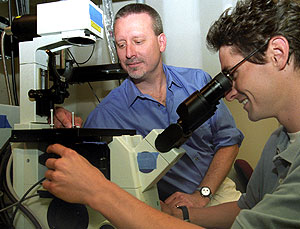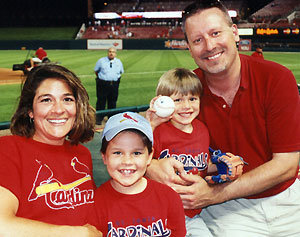Richard A. Loomis, Ph.D., associate professor of chemistry in Arts & Sciences, hears it all the time: “People say, ‘You don’t look like a scientist,'” he says. “You look like a basketball player, or, an average guy, but not a scientist.
“And I think: ‘What’s a scientist supposed to look like?’ I like to go places and let people know that we scientists are good people and we care about research, in addition to the kinds of students we have here, and we care about learning, no matter what we look like.”

Well, he is 6’7″ and 200-plus pounds, with an athlete’s relaxed confidence and big hands anathema to a chemistry beaker. A basketball player, he was recruited widely by universities across all NCAA divisions, including Syracuse, Penn State and Dartmouth.
Legendary Syracuse coach Jim Boeheim invited Loomis to his summer camp in 1984.
“A group of us were shooting around the first day when Boeheim’s assistant comes out and says, ‘Jim, I got somebody you want to meet, Rony Seikaly,'” Loomis says, grinning at the sound of the future NBA first-round draft pick’s name.
“Well, we didn’t see Jim ’til late the next day. Seikaly went on to play in the camp, and his team just crushed mine. He got a scholarship, and I was invited to walk on. Since I knew I wasn’t headed to the NBA anytime in the near future, I chose to attend a good Division III school.”
Loomis chose Dickinson College in central Pennsylvania, but it wasn’t an easy decision — he’d been accepted by 27 schools.
“It was getting near the decision deadline, and my parents took me and my friends out for dinner around my birthday and suggested Dickinson because they knew and liked the coach, Gene Evans. So I just went with that,” he says. “Follow your gut; that’s what I’ve done all my life.”
At Dickinson, he thrived both on the court and in the classroom, and he met his future wife, Toni, at the scorekeeper’s table — that was her work-study job. His was in sports medicine. He worked with the Washington Redskins when they trained at Dickinson in the summers, taping ankles, helping athletes with physical therapy and even working out with the likes of John Riggins, Doug Williams, Mark Rypien and the beloved “Hogs,” the Redskins’ ebullient offensive linemen.
“Dickinson College put out a tremendous food spread, day after day,” he recalls. “Steak, shrimp, lobster, king crab. Well, the Hogs got tired of it, and one day Joe Jacoby asked me to drive them to Wendy’s, where Russ Grimm orders three triples, two fish sandwiches, four potatoes and three diet Cokes — he was watching his weight, you see.
“While he’s putting that away, Jacoby grabs the microphone behind the counter and points Grimm out to the lunch crowd, marveling at the big guy’s appetite. It was hysterical.”
During his sophomore year — while enrolled in a program for business and economics — Loomis had to take a required policy and management studies course that was oversubscribed.
He was advised to wait another year and the very next day, the chair of the physics department suggested Loomis major in a science.
He took the bait and immediately switched academic tracks. The adviser said he’d rarely seen a non-science major with the perfect grade-point average that Loomis carried in his science courses.
“I thought it over,” Loomis recalls. “Science was fun for me. Business was something just to make a living. I decided it would be much better figuring out how things happen than trying to pick stocks. I followed my gut again.”

After undergraduate, he got a nice offer to be a technician at the Naval Research Laboratory. On his second visit there, he got the epiphany that a technician’s job wasn’t for him, and he went home to Mountain Top in the Pocono Mountains and furiously applied to graduate schools, even though he was past the deadline for many.
Princeton, Yale and Penn, nonetheless, admitted him, and he chose Penn because it was in Philadelphia, Toni’s hometown.
Loomis is a physical chemist whose research interests are centered on probing and controlling reaction dynamics at the atomic level.
Loomis recalls that these interests first developed in his first high-school chemistry class.
While he could comprehend that two chemicals, when mixed together in a beaker, would react forming different products when the appropriate temperature conditions were achieved, he still questioned exactly how the reaction between the molecules within the chemicals occurred.
While his teachers, and later his professors, could make solid conjectures at the mechanisms of these reactions, the precise details such as geometries, motions and timescales still remained unknown.
What Loomis wanted was to closely examine a molecule and videotape that molecule as it approached a reaction partner, then observe the two reactants combine as an intermediate and witness the intermediate evolve into product molecules.
Today, part of Loomis’ research group is approaching this concept with a combination of established molecular beam techniques that allow them to cool reactants to the lowest possible temperatures — about negative-272 degrees Celsius — and sophisticated laser technology which, in turn, enables them to initiate the reactions with specific energies and preferred orientations at well-defined times.
They are able to see geometries changing, bonds breaking and new bonds forming.
Understanding the mechanics and physics of this phenomenon could enable new directions for chemistry.
The basic question that haunted Loomis since he was 14 years old has spawned research that has provided his doctoral thesis, granted him tenure and is funded by the Packard Foundation and the National Science Foundation.
He’s especially excited about a new research direction and a proposal sent to the Department of Energy that involves collaboration with chemistry department colleague William Buhro, Ph.D., and University physicist Daniel Leopold, Ph.D.
The three want to develop a better solar cell, one that would capture solar energy at perhaps a 70 percent rate, compared with the meager 5-10 percent that most collectors get now.
|
Richard A. Loomis Title: Associate professor of chemistry in Arts & Sciences Education: B.S., 1989, Dickinson College, physics, chemistry, mathematics; Ph.D., University of Pennsylvania, chemistry; postdoctoral fellow, 1996-98, National Institute of Standards and Technology, University of Colorado Family: Wife, Toni (administrative assistant in International Studies in Arts & Sciences); daughter, Adina (7); son, Eric (4) Hobbies: Basketball, softball, science Quote: “My dad asks: ‘Why do you work so much?’ and I tell him it’s not all work. It’s my passion. Science is fun and exciting, especially when you’re getting good results.” Courses he regularly teaches: General Chemistry 111 A; Physical Chemistry (junior level) Chemistry 401; and graduate-level Molecular Spectroscopy, Chemistry 548 Recent (since 2005) University activities: Member, Faculty Council; Chair , Executive Committee of the Graduate Council; Faculty Associate for William Greenleaf Eliot College; Florence Moog Fellowships in the Biological Sciences and Chemistry Selection Committee |
They will rely on Buhro’s world-renowned expertise in making semiconducting nano-wires, Leopold’s experience with semiconductor nanostructures and Loomis’ measuring techniques.
“I have the good fortune to be Rich’s colleague and collaborator,” says Buhro, the George E. Pake Professor in Arts & Sciences. “We have taught together and published together, to my great advantage.
“Everything about Rich Loomis is large. He towers over his peers. He has an enormous enthusiasm for science, research, teaching and learning. And he has a huge, gregarious heart for including those around him in his work, or assisting others with their work. Rich is a gigantic colleague and teacher, and having him at Washington University has brought very big fun and excitement.”
Loomis has built a confocal microscope that can measure a charge from one point on a nanowire and then measure in femtoseconds — that’s 10 to the minus 15 seconds — how long it takes the charge to move along the wire.
“The ultimate hope is to be able to use solar energy more effectively so we can wean society off fossil fuels,” Loomis says.
Loomis is a member of the Center for Materials Innovation (CMI), which enables collaborators from across the WUSTL campuses to make basic and applied advances in materials research, touching many aspects of daily life.
Many of Loomis’ collaborators are members of CMI, directed by Stuart Solin, Ph.D., the Charles M. Hohenberg Professor of Physics.
“It’s fun being a physical chemist,” Loomis says. “I do measurements, build instruments, think about science, and now through collaborations I’m learning how to synthesize and become a more complete scientist. Washington University is a model of collaboration.”
Loomis applied to the University on the urging of a friend who is a University alum, Becky Schwartz, now a scientist with the FBI.
“At the last second I applied,” he recalls. “I’d had no interest before in the Midwest. But I looked closer at the faculty — lots of big names in chemistry — and I was so impressed on my visit here. We love living in St. Louis.”
Today the shoe (size 15) is on the other foot for Loomis. Instead of being recruited, he is the recruiter.
In China, he plies his warmth and affability on graduate-school candidates a couple of times a year, and he also goes to historically African-American colleges, such as Atlanta’s Morehouse College, to spread the word about WUSTL, encourage applications and explain what it’s like living and working in the Midwest.
He and colleague Kevin Moeller, Ph.D., professor of chemistry, hope to get a minority research summer program in chemistry running some day.
“Simply put, I have nearly $3 million in equipment in my lab, and most smaller schools can’t afford those kinds of things,” he says.
“Why not invite some of their students to work with me and reap the benefits of our fantastic facilities and develop a good relationship with minority-based schools who don’t have this kind of money or facilities?”